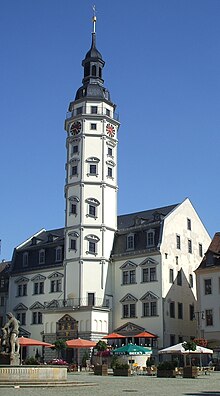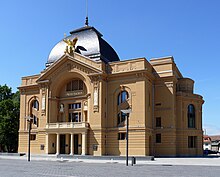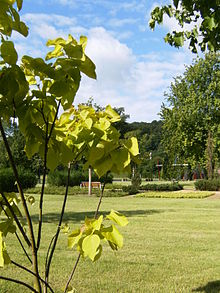Sights in Gera
Gera is not a classic tourist or excursion destination like Erfurt or Weimar , but still has numerous sights. For centuries it was the royal seat of the Counts and Princes of Reuss , but by the 19th century it had a more industrial character. In addition, the city fire of 1780, the destruction in the Second World War and its function as a district town between 1952 and 1990 subjected it to constant redesign and redesign. But, unlike most other cities in the GDR, Gera had a redeveloped city center even before 1990. Because of the Ronneburg- based Wismut, there was always a certain amount of capital available, so that the inner city could also be rebuilt in an old town-friendly manner. In addition, the city experienced a boom through the 2007 Federal Horticultural Show , for example the theater was renovated in advance.
Architectural monuments
town hall
The town hall of Gera is one of the city's landmarks. The first town hall, of which no image has survived, is said to have been built in 1254. It was destroyed in the Saxon Fratricidal War in 1450 and then rebuilt.
Today's town hall was built between 1573 and 1575 in the Renaissance style . It was probably designed by Nicol Gromann from Torgau , who had designed the very similar Altenburg town hall ten years earlier .
The richly decorated main portal on the market side is worth seeing, on which a permanently attached metal rod with the length of a Gera cubit (length measure for cloth, which could vary considerably depending on the region and city) still today of the earlier importance of Gera for cloth production and the cloth trade announces.
City pharmacy
- Main article: City pharmacy (Gera)
The building of the city pharmacy at the confluence of the Kleine Kirchstrasse in the market was built in 1592 and is thus the second Renaissance building preserved in Gera. It is worth seeing because of its richly decorated bay window from 1606.
The city pharmacy was founded around the same time, namely in 1602, but has only been housed in this building since the 19th century.
Samson Fountain
- Main article: Simsonbrunnen (Gera)
The Simson fountain in the middle of the market square represents the biblical lion-slayer Simson . It was built in 1685 by Caspar Junghans the Elder. Ä. from Rochlitz created in 1932 renewed after a storm damage and 1979 again replaced by a copy.
Geraer cave
- Main article: Geraer Höhler
The Gera caves are underground beer storage rooms that can be found under almost all houses in the old town. Some caves can be visited today.
theatre
- Main article: Big house (Gera)
After the first Gera theater was built on today's Puschkinplatz at the end of the 18th century, today's theater was built between 1900 and 1902 in the Untermhaus district according to plans by the important German theater architect Heinrich Seeling (for example, theaters in Aachen , Breslau , Freiburg im Breisgau , Berlin , Frankfurt am Main and Nuremberg ). It includes a hall used for drama and opera performances and a concert hall. Outside and especially inside, it impresses with a brilliant Art Nouveau style , making it one of the few German theaters in this architectural style. The theater, which was originally run in private and public (princely) hands, became the "Princely Court Theater" in 1908 and became the private property (i.e. public property) of the Russian prince. Heinrich XLV was the main artist . who shaped the theater as a consultant, director, dramaturge and author. The theater experienced its heyday in the 1920s. Particularly with the playing of contemporary dramas, it attracted numerous important actors such as Bernhard Minetti . Although the theater suffered bomb damage during the World War, the reopening took place on September 15, 1945 at the urging of the Soviet city commandant with Mozart's "Marriage of Figaro"; A flak bogie now served as a rotating platform. Modernization measures in the 1950s and 1960s redesigned the interior in a modernist style. After violent protests by the population, which finally turned to Walter Ulbricht , the interior from 1902 was restored after Ulbricht's intervention.
Osterstein Castle
- Main article: Osterstein Castle (Gera)
From the former residential palace of the Reussians , which was located on the Hainberg above Untermhaus , only a few outbuildings and the tower are preserved today. After the heavy destruction on April 6, 1945, the ruins of the castle were blown up in 1962.
On the Hainberg there was already a Neolithic rampart, on the remains of which a castle was built in the 12th century. However, this was only important for a short time. It was not until 1450, after the Saxon Fratricidal War, that the gentlemen of Gera moved their seat from the city castle, which had not been preserved, in the southwest of Gera's old town back to the Hainberg. In the 16th and 17th centuries there was brisk construction activity in the complex, which has been known as the Osterstein since 1581 .
Today there is a restaurant built in the 1960s on the Osterstein. The keep, which is also the oldest part of the old palace complex, is used as a lookout tower.
Schulenburg villa
- Main article: House Schulenburg
The villa , built in 1913 and 1914 by Henry van de Velde for the Gera industrialist Schulenburg, is one of the few works by this outstanding Art Nouveau artist that has survived. Van de Velde was responsible for the design and execution of both the building and the interior. The entire facility, which suffered a lot from the World War and its conversion during the GDR era, has been extensively restored and today in 2006 it houses various non-profit institutions. The Villa Schulenburg is an architectural monument of first international rank. Furthermore, Gera houses over 100 villas, some of which are listed in the article Villas in Gera .
There are also several objects in the city in the style of the New Building, such as the Halpert House, which was built in 1925 by Thilo Schoder .
city wall
In the south of the old town there is still a large continuous piece of the Gothic city wall on the city moat. It dates from the 2nd half of the 15th century and still has an eight meter high shell tower.
Reussian government building
The three-story baroque building on Johannisplatz was built between 1720 and 1722. Parts of the north wing date from the 16th century. The central projection is four-story and has a pilaster structure with a triangular gable. The building has not been renovated.
The Rutheneum high school, which was completed in 1887 and has existed as an institution since 1608, is in the immediate vicinity. Since 1993 the school has been called Goethe-Gymnasium / Rutheneum since 1608 .
Handelshof
The first skyscraper in the city of Gera was built in 1928 and 1929 by the Berlin architect Hans Brandt. The two-wing building complex is dominated by the ten-story, 34-meter high-rise tower. The municipal savings bank has had its headquarters in the building since it was built, and today it is the Sparkasse Gera-Greiz .
Ferberturm
The 21-meter-high observation tower on the Ronneburger Höhe, built in 1874 and 1875, offers a view of the city from the southeast and was designed by the councilor and mineralogist Dr. Moritz Rudolf Ferber (1805–1875) built from Leumnitzer Zechsteinrauchwacke.
Liebig's garden house
In 1740 this baroque garden house was built outside the city wall. The Amthorsche commercial college moved here in 1861. Today the building is used for other commercial purposes and the garden has retained its historical appearance.
Tinz Castle
- Main article: Tinz Castle
The baroque summer residence of the Princes of Reuss, built in 1745, is located in the district of the same name and stands on a former moated castle.
Churches
Salvator Church
- Main article: Salvatorkirche (Gera)
The baroque St. Salvator Church from 1717 to 1720 is located on the Nicolaiberg, the highest point in the old town. The tower was not completed until 1778, burned down only two years later in the great city fire, but was rebuilt true to the original. Today's interior of the church is shaped by Art Nouveau .
Johanniskirche
- Main article: Johanniskirche (Gera)
The neo-Gothic St. John's Church on Clara-Zetkin-Straße was built between 1881 and 1884 and is the largest church in the city. It was built as a successor to the Johanniskirche on Johannisplatz, which burned down in 1780.
Marienkirche
- Main article: Marienkirche (Gera)
The late Gothic St. Mary's Church is located almost directly on the White Elster and is the landmark of the Gera district of Untermhaus . Erected around 1440, it houses a precious late Gothic altar donated by the Kudorf and Waltheym families. The chancel is said to have been built as early as 1193, making the Marienkirche one of the oldest churches in East Thuringia. Together with the Untermhausen Bridge, the Marienkirche forms the most photographed view of Gera.
Trinity Church
- Main article: Trinity Church (Gera)
The Trinity Church from 1609 is the oldest church in the city center and was originally designed as a cemetery church.
Ursulakirche
The oldest church in today's urban area was built in the late Romanesque style in 1200 and has the oldest in Gera with the church bell dating from 1473.
Museums
city Museum
- Main article: Gera City Museum
The City Museum (former breeding and orphanage) was built between 1724 and 1739. Since 1914, the City Museum of History, founded in 1878, has been located there.
After several years of extensive renovation, which began at the same time as the construction of the neighboring Elster-Forum shopping center , it was reopened on May 20, 2005.
Natural History Museum
- Main article: Museum of Natural History (Gera)
The Museum of Natural History is housed in the so-called Schreiber House directly next to the Salvatorkirche, the only house in the old town that survived the fire of 1780 undamaged. It was named after the Schreiber family, who lived there from 1716 to 1847. After a temporary use as a court house and school, it has served as a museum since 1947.
Art gallery (orangery)
- Main article: Orangery (Gera)
The Gera art gallery is located in the Untermhaus district in the former Princely Russian orangery . It was built between 1729 and 1732 and has housed the Gera art collection since 1957.
Museum of Applied Arts
- Main article: Museum of Applied Arts (Gera)
The museum, which was set up as a museum for arts and crafts in 1984, is located in Ferber's House , built in 1760, the largest former town house in Gera's old town. Arts and crafts of the 20th century, photography, commercial graphics, design and Bauhaus ceramics are exhibited.
Otto Dix House
- Main article: Otto Dix House (Gera)
Otto Dix was born in 1891 in this building right next to the Marienkirche . On the occasion of his 100th birthday, the building was set up as a museum, which, in addition to a few smaller works with Christophorus, houses one of Dix's most important works.
Parks
Hofwiesenpark
- Main article: Hofwiesenpark
In 2007, the Hofwiesenpark formed the second exhibition area of the Federal Horticultural Show alongside the New Landscape in Ronneburg . There are two sports facilities on the site, the Hofwiesenbad and the Stadium of Friendship .
Animal park
- Main article: Gera Zoo
The largest zoo in East Thuringia was founded in 1962 and is inhabited by both domestic and exotic animals. A park railway runs through the site.
Kitchen garden
- Main article: Kitchen garden (Gera)
The baroque pleasure garden between the theater and the orangery was redesigned in 1729 according to the French model and is also given a monument group dedicated to the victims of fascism.












